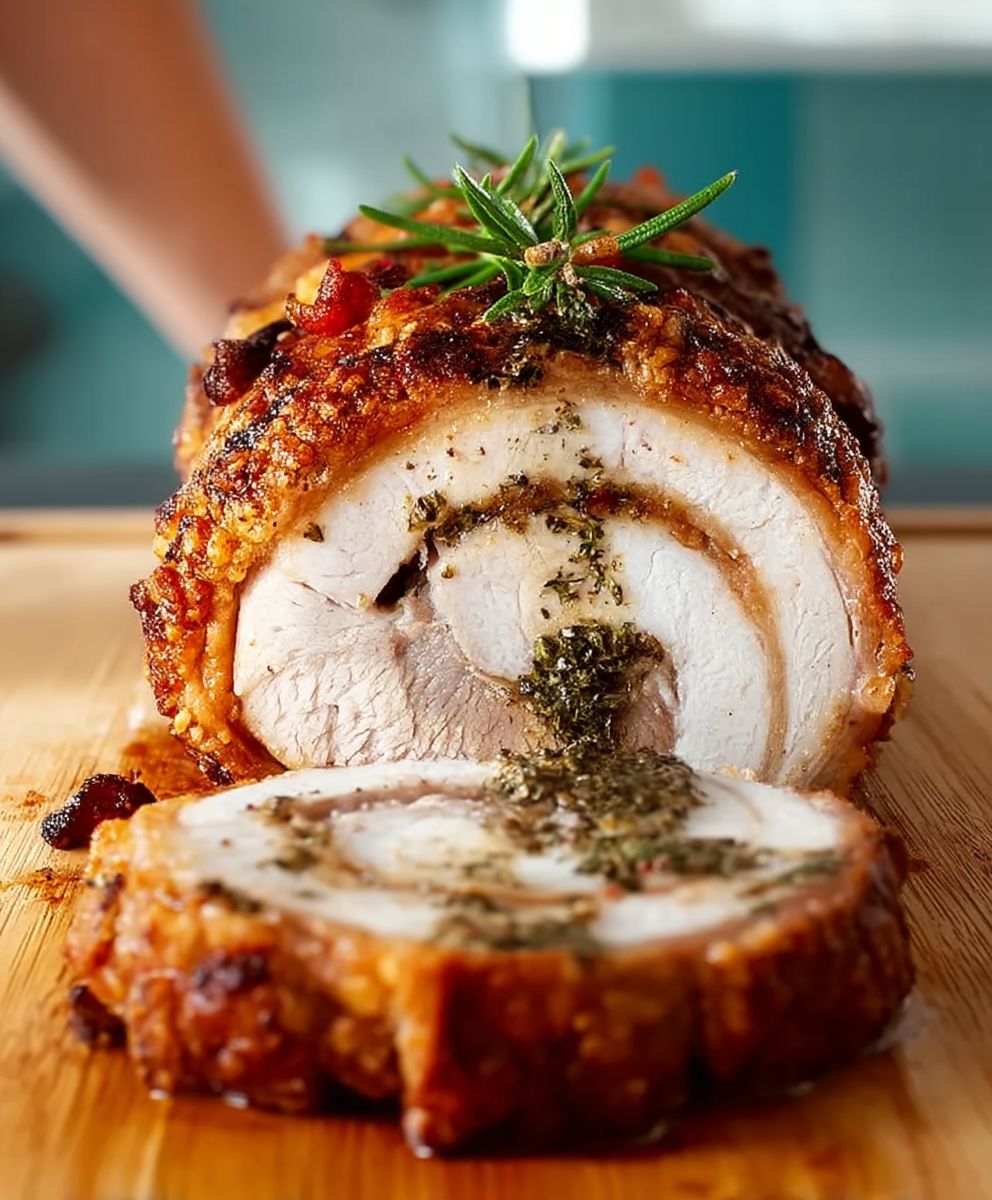Italian Porchetta: Prepare to be transported to the sun-drenched hills of Italy with every succulent bite! Imagine a symphony of crispy, crackling skin giving way to tender, herb-infused pork that melts in your mouth. This isn’t just a recipe; it’s an experience, a celebration of flavor that has been cherished for centuries.
Porchetta, a culinary masterpiece, boasts a rich history deeply rooted in central Italy, particularly in the regions of Lazio and Umbria. Traditionally, it was a dish reserved for special occasions, festivals, and communal gatherings, symbolizing abundance and shared joy. The preparation itself was a ritual, passed down through generations, with each family holding their own secret blend of herbs and spices.
What makes Italian Porchetta so irresistible? It’s the perfect marriage of textures and tastes. The crispy skin provides a satisfying crunch, contrasting beautifully with the juicy, flavorful meat. The aromatic herbs, often including rosemary, garlic, fennel, and sage, infuse the pork with a delightful fragrance and a complex, savory profile. Beyond its incredible taste, porchetta is also surprisingly versatile. Enjoy it sliced thinly in a crusty panini, as a centerpiece for a festive meal, or even cold as part of an antipasto platter. Its enduring popularity speaks volumes about its ability to captivate taste buds and evoke a sense of Italian tradition.

Ingredients:
- Pork Belly: 10-12 pound slab, skin on, scored
- Pork Loin: 3-4 pound boneless roast
- Fennel Seeds: 4 tablespoons, toasted
- Dried Rosemary: 2 tablespoons, crushed
- Dried Sage: 2 tablespoons, crumbled
- Garlic: 8-10 cloves, minced
- Lemon Zest: From 2 lemons
- Orange Zest: From 1 orange
- Red Pepper Flakes: 1-2 teaspoons (adjust to taste)
- Salt: 4 tablespoons, plus more for seasoning
- Black Pepper: 2 tablespoons, freshly ground, plus more for seasoning
- Olive Oil: 2 tablespoons
- Dry White Wine: 1/2 cup
- Chicken Broth: 1 cup
Preparing the Porchetta:
- Prepare the Pork Belly: Lay the pork belly skin-side down on a clean work surface. If your butcher hasn’t already scored the skin, use a sharp knife or a box cutter to score it in a crosshatch pattern, being careful not to cut into the meat. The scoring helps the skin render and become crispy during roasting. Aim for scores about 1 inch apart.
- Butterfly the Pork Belly: Carefully butterfly the pork belly by making a long, horizontal cut down the center, almost all the way through. Then, open it up like a book. This will create a larger surface area for the flavorful filling. If the belly is very thick, you can carefully slice it thinner in some areas to create a more even thickness.
- Prepare the Pork Loin: Trim any excess fat or silver skin from the pork loin. You want a relatively lean roast for the center of the porchetta.
Making the Herb Mixture:
- Toast the Fennel Seeds: In a dry skillet over medium heat, toast the fennel seeds for 2-3 minutes, or until fragrant. Be careful not to burn them. Let them cool slightly.
- Combine the Herbs and Spices: In a large bowl, combine the toasted fennel seeds, dried rosemary, dried sage, minced garlic, lemon zest, orange zest, red pepper flakes, salt, and black pepper. Add the olive oil and mix well to form a paste. This is your flavor bomb!
Assembling the Porchetta:
- Season the Pork Belly: Generously season the inside of the butterflied pork belly with salt and pepper. This is crucial for flavor penetration.
- Spread the Herb Mixture: Spread the herb mixture evenly over the inside of the pork belly, ensuring it covers every nook and cranny. Don’t be shy! This is where all the flavor comes from.
- Place the Pork Loin: Place the pork loin in the center of the seasoned pork belly. Try to position it so that it’s evenly distributed along the length of the belly.
- Roll the Porchetta: Carefully roll the pork belly around the pork loin, creating a tight, even roll. This can be a bit tricky, but take your time and use your hands to shape it as you go.
- Tie the Porchetta: Using butcher’s twine, tie the porchetta tightly at 1-2 inch intervals. This will help it maintain its shape during cooking and ensure even cooking. Start by tying a knot at one end, then loop the twine around the porchetta, pulling it tight as you go. Secure each loop with a knot.
- Season the Outside: Generously season the outside of the porchetta with salt and pepper. Pay special attention to the skin, as this will become the crispy crackling.
- Refrigerate Overnight: Wrap the tied porchetta tightly in plastic wrap and refrigerate it overnight (or up to 24 hours). This allows the flavors to meld and the skin to dry out, which is essential for achieving crispy crackling.
Roasting the Porchetta:
- Preheat the Oven: Preheat your oven to 450°F (232°C).
- Prepare the Roasting Pan: Place the porchetta on a wire rack set inside a roasting pan. This allows air to circulate around the porchetta, promoting even cooking and crispy skin. Pour the dry white wine and chicken broth into the bottom of the roasting pan. This will create steam and prevent the porchetta from drying out.
- Roast at High Heat: Roast the porchetta at 450°F (232°C) for 30 minutes. This initial blast of high heat helps to render the fat and crisp up the skin.
- Reduce the Heat: Reduce the oven temperature to 325°F (163°C) and continue roasting for 3-4 hours, or until the internal temperature of the pork loin reaches 145°F (63°C). Use a meat thermometer to check the temperature in the thickest part of the loin.
- Basting (Optional): Baste the porchetta with the pan juices every hour or so. This helps to keep it moist and flavorful.
- Crisp the Skin (If Needed): If the skin isn’t as crispy as you’d like after the initial roasting time, increase the oven temperature back to 450°F (232°C) for the last 15-20 minutes of cooking. Watch it carefully to prevent burning. You can also use the broiler for a few minutes, but keep a close eye on it!
- Rest the Porchetta: Once the porchetta is cooked through, remove it from the oven and let it rest for at least 30 minutes before slicing. This allows the juices to redistribute, resulting in a more tender and flavorful roast. Tent it loosely with foil to keep it warm.
Slicing and Serving:
- Remove the Twine: Before slicing, carefully remove the butcher’s twine from the porchetta.
- Slice the Porchetta: Use a sharp carving knife to slice the porchetta into thin slices. Aim for slices about 1/4 inch thick. The crispy skin should shatter beautifully as you slice.
- Serve: Serve the porchetta warm, either on its own or as part of a sandwich. It’s delicious with crusty bread, roasted vegetables, or a simple salad. The pan juices can be strained and served as a sauce.
Tips for Perfect Porchetta:
- Scoring the Skin: Don’t be afraid to score the skin deeply. This is key to achieving crispy crackling.
- Drying the Skin: Refrigerating the porchetta uncovered overnight helps to dry out the skin, which is essential for crisping.
- Temperature Control: Using a meat thermometer is the best way to ensure that the pork loin is cooked to the correct temperature.
- Resting Time: Don’t skip the resting time! It makes a huge difference in the tenderness and juiciness of the porchetta.
- Don’t Overcrowd the Pan: Make sure there’s enough space around the porchetta in the roasting pan for air to circulate.
Variations:
- Add Other Herbs: Feel free to experiment with other herbs, such as thyme, oregano, or marjoram.
- Use Different Citrus: You can use all lemon zest or all orange zest, or even add grapefruit zest for a unique flavor.
- Add Chili Paste: For a spicier porchetta, add a tablespoon or two of chili paste to the herb mixture.
- Stuff with Sausage: For an even richer porchetta, you can stuff it with Italian sausage.
Troubleshooting:
- Skin Not Crispy: If the skin isn’t crispy enough, try increasing the oven temperature or using the broiler for the last few minutes of cooking. Make sure the skin is dry before roasting.
- Pork Loin Too Dry: If the pork loin is too dry, try basting the porchetta more frequently with the pan juices. You can also add more chicken broth to the roasting pan. Make sure you are not overcooking it.
- Porchetta Falling Apart: If the porchetta is falling apart, make sure you’ve tied it tightly enough with butcher’s twine. You can also use more twine if needed.

Conclusion:
This isn’t just another pork recipe; it’s an experience. The crispy, crackling skin giving way to succulent, herb-infused meat is a symphony of textures and flavors that will transport you straight to the Italian countryside. Trust me, once you’ve tasted this Italian Porchetta, you’ll understand why it’s a culinary masterpiece worth every ounce of effort. It’s a showstopper, a conversation starter, and a dish that will leave your guests utterly impressed.
But why is this recipe a must-try? Beyond the incredible taste, it’s about the process. It’s about slowing down, connecting with your food, and creating something truly special. The aroma that fills your kitchen as it roasts is intoxicating, building anticipation for the feast to come. And the satisfaction of presenting this beautiful, golden-brown roast to your loved ones is simply unmatched. It’s more than just cooking; it’s creating a memory.
Now, let’s talk about serving suggestions. While this Italian Porchetta is divine on its own, sliced thinly and served with a simple salad, there are endless possibilities to explore. Imagine it nestled in a crusty panini with provolone cheese and roasted peppers a perfect lunch or light dinner. Or, shred the leftover meat and toss it with pasta in a creamy pesto sauce for a truly decadent meal. For a more casual gathering, serve it on slider buns with a tangy coleslaw.
And don’t be afraid to experiment with variations! Want to add a little heat? Incorporate some Calabrian chili flakes into the herb mixture. Prefer a sweeter flavor profile? A drizzle of honey over the skin during the last hour of roasting will create a beautiful glaze. You can even adjust the herbs to your liking rosemary, sage, and fennel are classic choices, but thyme, oregano, and marjoram would also be delicious additions. Consider adding some lemon or orange zest to the herb mixture for a brighter, more citrusy flavor. Play around with different cuts of pork as well. While a whole pork belly is traditional, a pork shoulder or loin can also be used, although the cooking time will need to be adjusted accordingly.
I know this recipe might seem a little intimidating at first, but I promise you, it’s worth the effort. Break it down into manageable steps, follow the instructions carefully, and don’t be afraid to ask questions if you get stuck. Remember, cooking is a journey, not a destination. Embrace the process, have fun, and don’t be afraid to make mistakes. That’s how you learn and grow as a cook.
So, what are you waiting for? Gather your ingredients, roll up your sleeves, and get ready to create some culinary magic. I’m confident that this Italian Porchetta will become a new favorite in your household.
I’m so excited for you to try this recipe! Once you do, please come back and share your experience in the comments below. I’d love to hear about your variations, your serving suggestions, and any tips or tricks you discovered along the way. Let’s build a community of Porchetta lovers and inspire each other to create delicious meals! Bon appétit!
Italian Porchetta: A Guide to Authentic Flavor and Preparation
A show-stopping Porchetta featuring a flavorful herb-stuffed pork belly wrapped around a tender pork loin, roasted to crispy perfection.
Ingredients
- Pork Belly: 10-12 pound slab, skin on, scored
- Pork Loin: 3-4 pound boneless roast
- Fennel Seeds: 4 tablespoons, toasted
- Dried Rosemary: 2 tablespoons, crushed
- Dried Sage: 2 tablespoons, crumbled
- Garlic: 8-10 cloves, minced
- Lemon Zest: From 2 lemons
- Orange Zest: From 1 orange
- Red Pepper Flakes: 1-2 teaspoons (adjust to taste)
- Salt: 4 tablespoons, plus more for seasoning
- Black Pepper: 2 tablespoons, freshly ground, plus more for seasoning
- Olive Oil: 2 tablespoons
- Dry White Wine: 1/2 cup
- Chicken Broth: 1 cup
Instructions
- Prepare the Pork Belly: Lay the pork belly skin-side down on a clean work surface. If your butcher hasn’t already scored the skin, use a sharp knife or a box cutter to score it in a crosshatch pattern, being careful not to cut into the meat. The scoring helps the skin render and become crispy during roasting. Aim for scores about 1 inch apart.
- Butterfly the Pork Belly: Carefully butterfly the pork belly by making a long, horizontal cut down the center, almost all the way through. Then, open it up like a book. This will create a larger surface area for the flavorful filling. If the belly is very thick, you can carefully slice it thinner in some areas to create a more even thickness.
- Prepare the Pork Loin: Trim any excess fat or silver skin from the pork loin. You want a relatively lean roast for the center of the porchetta.
- Toast the Fennel Seeds: In a dry skillet over medium heat, toast the fennel seeds for 2-3 minutes, or until fragrant. Be careful not to burn them. Let them cool slightly.
- Combine the Herbs and Spices: In a large bowl, combine the toasted fennel seeds, dried rosemary, dried sage, minced garlic, lemon zest, orange zest, red pepper flakes, salt, and black pepper. Add the olive oil and mix well to form a paste. This is your flavor bomb!
- Season the Pork Belly: Generously season the inside of the butterflied pork belly with salt and pepper. This is crucial for flavor penetration.
- Spread the Herb Mixture: Spread the herb mixture evenly over the inside of the pork belly, ensuring it covers every nook and cranny. Don’t be shy! This is where all the flavor comes from.
- Place the Pork Loin: Place the pork loin in the center of the seasoned pork belly. Try to position it so that it’s evenly distributed along the length of the belly.
- Roll the Porchetta: Carefully roll the pork belly around the pork loin, creating a tight, even roll. This can be a bit tricky, but take your time and use your hands to shape it as you go.
- Tie the Porchetta: Using butcher’s twine, tie the porchetta tightly at 1-2 inch intervals. This will help it maintain its shape during cooking and ensure even cooking. Start by tying a knot at one end, then loop the twine around the porchetta, pulling it tight as you go. Secure each loop with a knot.
- Season the Outside: Generously season the outside of the porchetta with salt and pepper. Pay special attention to the skin, as this will become the crispy crackling.
- Refrigerate Overnight: Wrap the tied porchetta tightly in plastic wrap and refrigerate it overnight (or up to 24 hours). This allows the flavors to meld and the skin to dry out, which is essential for achieving crispy crackling.
- Preheat the Oven: Preheat your oven to 450°F (232°C).
- Prepare the Roasting Pan: Place the porchetta on a wire rack set inside a roasting pan. This allows air to circulate around the porchetta, promoting even cooking and crispy skin. Pour the dry white wine and chicken broth into the bottom of the roasting pan. This will create steam and prevent the porchetta from drying out.
- Roast at High Heat: Roast the porchetta at 450°F (232°C) for 30 minutes. This initial blast of high heat helps to render the fat and crisp up the skin.
- Reduce the Heat: Reduce the oven temperature to 325°F (163°C) and continue roasting for 3-4 hours, or until the internal temperature of the pork loin reaches 145°F (63°C). Use a meat thermometer to check the temperature in the thickest part of the loin.
- Basting (Optional): Baste the porchetta with the pan juices every hour or so. This helps to keep it moist and flavorful.
- Crisp the Skin (If Needed): If the skin isn’t as crispy as you’d like after the initial roasting time, increase the oven temperature back to 450°F (232°C) for the last 15-20 minutes of cooking. Watch it carefully to prevent burning. You can also use the broiler for a few minutes, but keep a close eye on it!
- Rest the Porchetta: Once the porchetta is cooked through, remove it from the oven and let it rest for at least 30 minutes before slicing. This allows the juices to redistribute, resulting in a more tender and flavorful roast. Tent it loosely with foil to keep it warm.
- Remove the Twine: Before slicing, carefully remove the butcher’s twine from the porchetta.
- Slice the Porchetta: Use a sharp carving knife to slice the porchetta into thin slices. Aim for slices about 1/4 inch thick. The crispy skin should shatter beautifully as you slice.
- Serve: Serve the porchetta warm, either on its own or as part of a sandwich. It’s delicious with crusty bread, roasted vegetables, or a simple salad. The pan juices can be strained and served as a sauce.
Notes
- Scoring the Skin: Don’t be afraid to score the skin deeply. This is key to achieving crispy crackling.
- Drying the Skin: Refrigerating the porchetta uncovered overnight helps to dry out the skin, which is essential for crisping.
- Temperature Control: Using a meat thermometer is the best way to ensure that the pork loin is cooked to the correct temperature.
- Resting Time: Don’t skip the resting time! It makes a huge difference in the tenderness and juiciness of the porchetta.
- Don’t Overcrowd the Pan: Make sure there’s enough space around the porchetta in the roasting pan for air to circulate.
- Add Other Herbs: Feel free to experiment with other herbs, such as thyme, oregano, or marjoram.
- Use Different Citrus: You can use all lemon zest or all orange zest, or even add grapefruit zest for a unique flavor.
- Add Chili Paste: For a spicier porchetta, add a tablespoon or two of chili paste to the herb mixture.
- Stuff with Sausage: For an even richer porchetta, you can stuff it with Italian sausage.
- Skin Not Crispy: If the skin isn’t crispy enough, try increasing the oven temperature or using the broiler for the last few minutes of cooking. Make sure the skin is dry before roasting.
- Pork Loin Too Dry: If the pork loin is too dry, try basting the porchetta more frequently with the pan juices. You can also add more chicken broth to the roasting pan. Make sure you are not overcooking it.
- Porchetta Falling Apart: If the porchetta is falling apart, make sure you’ve tied it tightly enough with butcher’s twine. You can also use more twine if needed.




Leave a Comment